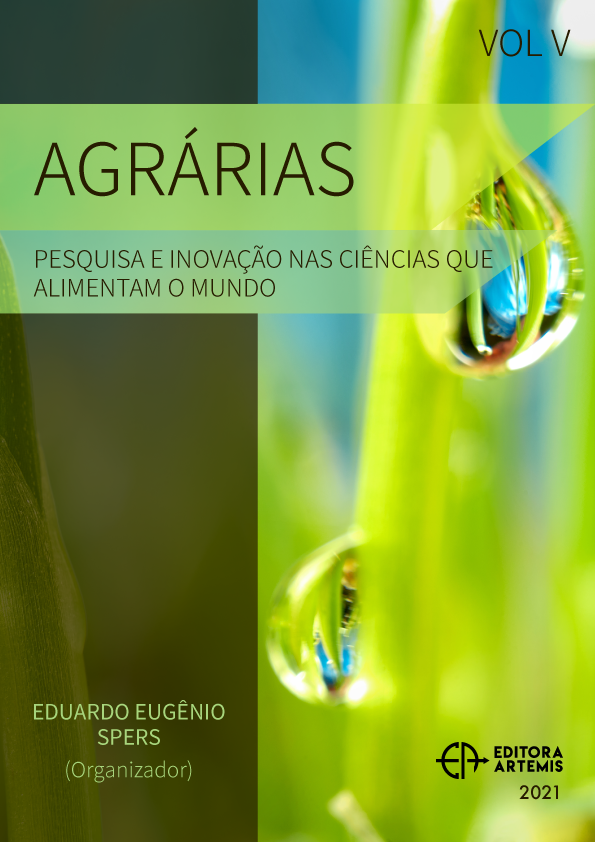
MANEJO AGROECOLÓGICO DO SOLO: ANÁLISE E CONSERVAÇÃO DE SOLOS NO MODELO AGROFLORESTAL
Sistemas Agroflorestais (SAF) são caracterizados pela produção integrada de culturas agrícolas e florestais, mas que podem da mesma forma, ser associados à produção animal. A consorciação de espécies vegetais compatíveis, propicia o equilíbrio dos sistemas de produção, uma vez que a diversificação de vegetais favorece a utilização radicular dos solos pela diferença de profundidade das raízes, além da regulação equilibrada de “pragas” e doenças. SAFs propiciam regeneração da fauna e matriz florestal determinando benefícios também no seu entorno. O objetivo deste trabalho foi restaurar a área de proteção permanente de uma nascente, aplicando manejo agroflorestal. Foram realizadas análises químicas e físicas do solo, tornando possível planejar os modelos de manejo e plantio. Posteriormente, foi realizada capina seletiva, poda e adubação verde em cinco canteiros. O plantio foi realizado utilizando espécies de interesse alimentício, como mandioca (Manihot esculenta Crantz), bananeiras (Musa paradisiaca L.), plantas arbóreas e frutíferas, como aroeiras pimenteiras (Schinus terebinthifoli Raddi) e cedros (Cedrela fissilis Vell). O plantio melhorou a qualidade do solo, observando-se aumento dos teores de fósforo, cálcio e magnésio. As análises de solo foram essenciais para o monitoramento e correções necessárias, proporcionando a determinação das estratégias para preservação associada à produção biodiversificada de alimentos. Adição de espécies nativas influenciou positivamente a biodiversidade e qualidade do solo. Adicionalmente, a longo prazo poderá favorecer a economia e sustentabilidade da propriedade rural. Dessa forma, e a partir dos resultados do presente estudo, foi possível concluir que a adequação do manejo às necessidades fisíco-químicas de um solo, propiciou a elaboração de consórcios de plantas relacionadas as demandas do mesmo. A melhoria da qualidade do solo, por meio de podas, gerando matéria orgânica diversificada, promoveu a diversificação da fauna, de maneira que a interação solo-microvida-mesovida-planta-clima, favoreceu o aumento de micro e macro nutrientes essenciais, aumentando a fertilidade e produtividade do solo.
MANEJO AGROECOLÓGICO DO SOLO: ANÁLISE E CONSERVAÇÃO DE SOLOS NO MODELO AGROFLORESTAL
-
DOI: 10.37572/EdArt_29042134711
-
Palavras-chave: MANEJO AGROECOLÓGICO DO SOLO: ANÁLISE E CONSERVAÇÃO DE SOLOS NO MODELO AGROFLORESTAL
-
Keywords: Agroecology, Agroforestry, Permanent Protection Area, Forest Restoration.
-
Abstract:
Agroforestry Systems (SAFs) are characterized by the integrated production of agricultural and forestry crops which can be associated with animal production. The intercropping of compatible plant species, provides the balance of production systems, since the diversification of plants favors the root use of soils due to the difference in depth of penetration of the roots, regulating pests and diseases. Thus, SAFs provide fauna and forest matrix regeneration, bringing benefits in their surroundings as well. The objective of this work was to restore a Permanent Protection Area of a spring water, through agroforestry management. Chemical and physical analyzes of the soil were realized, so that management and planting models could be planned. Subsequently, selective weeding, pruning and green manure were carried out in five flower beds. Seedlings of plants of food interest, such as manioc (Manihot esculenta Crantz) and banana (Musa paradisiaca L.), and fruit trees, such as peppermint (Schinus terebinthifoli Raddi) and cedars (Cedrela fissilis Vell) were planted. Planting improved soil quality demonstrated by the increase in phosphorus, calcium and magnesium. Soil analyzes were essential for the monitoring and necessary corrections, providing the determination of strategies for preservation associated with biodiversification production of food. The addition of native species influenced positivity the biodiversity and soil quality. In addition, in a long-term, it may favor the economy and sustainability of rural property. Thus, and from the results of the present study, it was possible to conclude that the adequacy of the management to the physicochemical needs of a soil, propitiates the elaboration of plant consortia related to the demands of the whole SAF. The increase in soil quality, through pruning, generating diversified organic matter, promoted the diversification of fauna, so that the interaction between soil/micro-life/meso-life/climate-plant, favoring the increase of essential micro and macro nutrients and increasing soil fertility and productivity.
-
Número de páginas: 11
- william ortega gonçalves
- Diego Resende Rodrigues
- Marcus Vinicius da Silva Rodrigues
- Igor Graciano
- Erika Cosendey Toledo de Mello Peixoto

